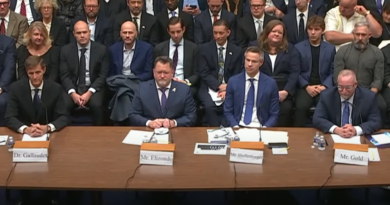Is the Nike trainer bubble on the verge of bursting? | Latest UK News
The trainer market is more diverse and competitive than ever before, and its biggest player has felt the pinch.
While new brands have been popping up and taking market share, Nike suffered its biggest single day drop in share price on record in late June.
A whopping $28bn (£21.6bn) was shaved off in market capitalisation overnight after the company’s management reported an expected sale drop in early 2025.
But why has this happened?
Nike remains the biggest sports retailer in the world and still has the largest slice of market share. According to analysts, however, strategic decisions at boardroom level have contributed to a downturn in its fortunes – with consumer concerns and the emergence of new competition also in play.
Shift in strategy
John Donahoe became Nike’s chief executive in January 2020 and was tasked with updating the company’s online operation and bringing in more digital revenue.
Mr Donahoe, 64, arrived from one of the world’s biggest ecommerce companies, eBay, and quickly began shifting Nike’s focus towards its digital sales efforts and away from the high street.
Shortly after, the COVID pandemic hit, and the world’s shoppers were forced online whether they liked it or not.
With people not going into offices to work, there was no need to buy smart, formal footwear. Comfortable, everyday shoe sales rose, and Nike’s profits surged past projections.
Everything looked to be going well, so Mr Donahoe doubled down, accelerating the digital strategy and moving Nike out of hundreds of bricks-and-mortar stores.
Soon, Nike had severed a third of its relationships with sales partners.
“The consumer today is digitally grounded and simply will not revert back,” said Mr Donahoe on an earnings call in 2020.
Nike executives believed they were the ones best able to deliver their vision straight to consumers, and they didn’t need retailers like FootLocker and JD Sports diluting that as middle men.
But as lockdowns ended across the world, people returned to stores and online sales slowed, and the decisions that had been made started to be questioned.
“I think they underestimated the cultural aspect of brick-and-mortar shopping as part of the social life of young consumers,” Daniel Herval, who worked at Nike between 2017-20 in product creation on some of its biggest trainers, including Air Max, Jordan and Air Force 1, told the Money blog.
“Nike thought people had shifted to online, and they’d left the brick-and-mortar experience behind.
“But as soon as things started reopening, the social aspect of shopping, the community bonding aspect of shopping, returned, and Nike weren’t really there.”
Nike had started to change tack by the time people returned to stores, but it had lost pace against other brands.
Competition and innovation
Nike’s rivals weren’t going to stand still while this was happening, and sure enough, retailers that had once had Nike shoes front and centre on their shelves looked for other brands to fill the space.
Newer brands like Asics, Deckers Outdoor’s HOKA and Roger Federer-backed On emerged, taking a steadily growing portion of the market share.
And those companies quickly began to show off new ideas, notably in a corner of the market that Nike has long dominated – performance running.
HOKA’s thick foam soles are a huge draw for runners, while On’s well-marketed (and now patented) cushioning system technology has proved popular for casuals and professionals alike.
Nike, it is perceived by some, has lagged behind in the sports lifestyle scene, too. Adidas’s Samba and Gazelle lines, and New Balance’s 990s, have grown in popularity – even Rishi Sunak notoriously owned a pair of Sambas…
So where has Nike’s innovation been during this time?
The air cushioning inside the soles of trainers – known as the Air Max bubble – debuted all the way back in 1978.
The flyknit material, which was released back in 2012, Mr Herval says, is the last major performance innovation that managed to trickle into the lifestyle brand in a major commercial way.
A survey of US teenagers by Piper Sandler earlier this year backed up the idea that while Nike remains the favourite, it was losing “mindshare” to innovative brands like Hoka and On.
Nike appears to have acknowledged the problem, announcing a “multi-year innovation cycle” in April.
Two key complaints from the streets
To find out how consumers feel about Nike’s shoes in 2024, there are few better places to go searching than The Basement.
Launched on Facebook over a decade ago, the online group of streetwear fanatics has just over 150,000 members from across the globe and is a go-to authority on all things street fashion, including trainers.
Need to check if the hoodie you just bought on eBay really is a vintage Ralph Lauren? Ask The Basement. Want to launch your own line of bespoke sunglasses but need advice starting a small fashion business? Ask The Basement.
Looking for consumers to tell you why fewer people are buying Nike trainers in 2024? You get the picture.
When we asked The Basement’s members for their thoughts on Nike, there were two issues that came back with almost every response.
The first of those is the price point, which is now largely unaffordable for the exact demographic that historically bought Nike’s trainers in droves.
Have a look on Nike’s website, and you’d be hard-pressed to find a new-release trainer costing less than £120. Most of the “hotly anticipated” shoes sit between the £150-£200 mark.
For the classic products, like the Air Max 95, a new pair starts at £174.99. Some traditionally cheaper options, like the Air Jordan 1s, are now around £130 on retailers including JD Sports, Size? and ASOS.
“£200 isn’t an accessible price point,” said one member of The Basement. “People have got older and smarter.”
“I worked for a footwear retailer for four years,” said another. “Nike’s biggest killer was easily their price hikes.
“When I started collecting Jordans they were £105, within 10 years the same model is £190 – you can’t justify that!”
The testimonies go on and on. As do those raising consumers’ second-biggest gripe with Nike trainers – quality control.
Anecdotal reports of botched products are not hard to find, with many buyers frustrated that, after spending a lot of money on new shoes, they’ve received trainers covered in glue stains, with mismatched logos, missing patterns, misshaped heels and more among the complaints.
Quality control is a hands-on process that involves both manual and automated procedures, and as such it is not foolproof.
But the sheer number of reports of errors indicates this is not just a few faulty Air Forces.
There are tens of millions of hits on TikTok for the term “Nike quality control” and – spoiler alert – most videos aren’t of people sharing how delighted they are with their new trainer purchases.
“Why would I spend £200 on a pair of Nike trainers that will probably arrive covered in glue stains and break after a month, when I could get a perfect pair of New Balance for £150?” asks a member of The Basement.
“Quality has taken a dive. Anyone who has ever worked for somewhere stocking Nike knows that glue smell off the pallet far too well,” says another.
Bouncing back via Paris
But it’s not all doom and gloom for Nike. There was a golden marketing ace up its sleeve this summer – Paris 2024.
The world’s biggest brands see the Olympics as an opportunity to get in front of a global audience, and Nike is no different. Good publicity and brand image can instil customer confidence and improve share price – getting things right in Paris was key.
The sportswear giant announced before the Games that it would be spending more on it than it had for any previous edition.
“This will be the most investment and the biggest moment for Nike in years,” Heidi O’Neill, Nike’s president of consumer, product and brand, said in April, three months before the Games began.
Nike secured itself as an official sponsor for Team USA, meaning so long as the athletes performed as expected, the swoosh would be on top of the podium.
And so it was. Simone Biles won three golds in gymnastics, Noah Lyles took 100m glory and swimmer Katie Ledecky featured on the podium four times.
Lifetime Nike endorser LeBron James laced up some very on-the-nose metallic gold style trainers from his own custom LeBron 22 signature line on his way to a gold medal.
- Powerful Typhoon Shanshan Approaches Japan, Prompts Emergency Warning
- CDC Confirms 21 Cases of Oropouche Fever in Travelers Returning from Cuba




 Source link
Source link


